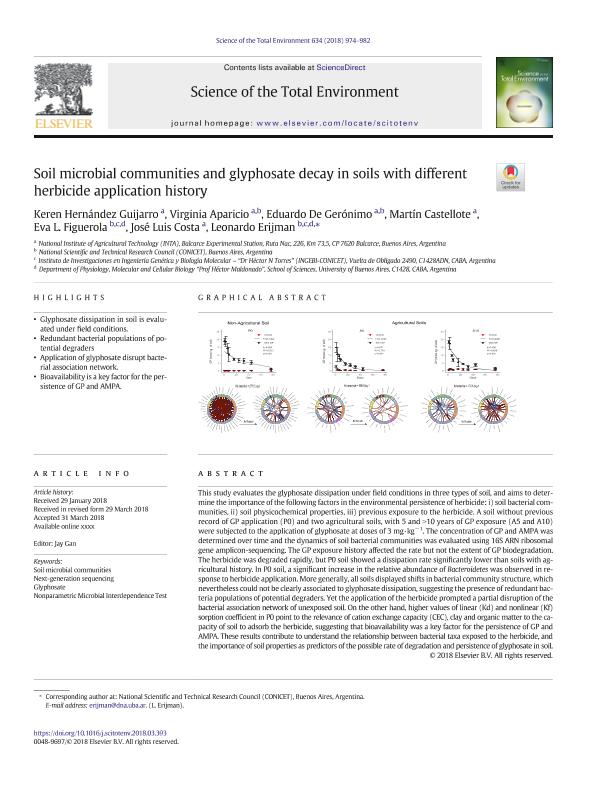Mostrar el registro sencillo del ítem
dc.contributor.author
Hernández Guijarro, Keren

dc.contributor.author
Aparicio, Virginia Carolina

dc.contributor.author
de Gerónimo, Eduardo

dc.contributor.author
Castellote, Martín Alfredo

dc.contributor.author
Figuerola, Eva Lucia Margarita

dc.contributor.author
Costa, Jose Luis

dc.contributor.author
Erijman, Leonardo

dc.date.available
2019-12-17T19:04:17Z
dc.date.issued
2018-09
dc.identifier.citation
Hernández Guijarro, Keren; Aparicio, Virginia Carolina; de Gerónimo, Eduardo; Castellote, Martín Alfredo; Figuerola, Eva Lucia Margarita; et al.; Soil microbial communities and glyphosate decay in soils with different herbicide application history; Elsevier; Science of the Total Environment; 634; 9-2018; 974-982
dc.identifier.issn
0048-9697
dc.identifier.uri
http://hdl.handle.net/11336/92399
dc.description.abstract
This study evaluates the glyphosate dissipation under field conditions in three types of soil, and aims to determine the importance of the following factors in the environmental persistence of herbicide: i) soil bacterial communities, ii) soil physicochemical properties, iii) previous exposure to the herbicide. A soil without previous record of GP application (P0) and two agricultural soils, with 5 and >10 years of GP exposure (A5 and A10) were subjected to the application of glyphosate at doses of 3 mg·kg−1. The concentration of GP and AMPA was determined over time and the dynamics of soil bacterial communities was evaluated using 16S ARN ribosomal gene amplicon-sequencing. The GP exposure history affected the rate but not the extent of GP biodegradation. The herbicide was degraded rapidly, but P0 soil showed a dissipation rate significantly lower than soils with agricultural history. In P0 soil, a significant increase in the relative abundance of Bacteroidetes was observed in response to herbicide application. More generally, all soils displayed shifts in bacterial community structure, which nevertheless could not be clearly associated to glyphosate dissipation, suggesting the presence of redundant bacteria populations of potential degraders. Yet the application of the herbicide prompted a partial disruption of the bacterial association network of unexposed soil. On the other hand, higher values of linear (Kd) and nonlinear (Kf) sorption coefficient in P0 point to the relevance of cation exchange capacity (CEC), clay and organic matter to the capacity of soil to adsorb the herbicide, suggesting that bioavailability was a key factor for the persistence of GP and AMPA. These results contribute to understand the relationship between bacterial taxa exposed to the herbicide, and the importance of soil properties as predictors of the possible rate of degradation and persistence of glyphosate in soil.
dc.format
application/pdf
dc.language.iso
eng
dc.publisher
Elsevier

dc.rights
info:eu-repo/semantics/openAccess
dc.rights.uri
https://creativecommons.org/licenses/by-nc-sa/2.5/ar/
dc.subject
SOIL MICROBIAL ECOLOGY
dc.subject
GLYPHOSATE
dc.subject.classification
Otras Ciencias de la Tierra y relacionadas con el Medio Ambiente

dc.subject.classification
Ciencias de la Tierra y relacionadas con el Medio Ambiente

dc.subject.classification
CIENCIAS NATURALES Y EXACTAS

dc.title
Soil microbial communities and glyphosate decay in soils with different herbicide application history
dc.type
info:eu-repo/semantics/article
dc.type
info:ar-repo/semantics/artículo
dc.type
info:eu-repo/semantics/publishedVersion
dc.date.updated
2019-10-16T16:00:38Z
dc.journal.volume
634
dc.journal.pagination
974-982
dc.journal.pais
Países Bajos

dc.journal.ciudad
Amsterdam
dc.description.fil
Fil: Hernández Guijarro, Keren. Instituto Nacional de Tecnología Agropecuaria. Centro Regional Buenos Aires Sur. Estación Experimental Agropecuaria Balcarce; Argentina
dc.description.fil
Fil: Aparicio, Virginia Carolina. Instituto Nacional de Tecnología Agropecuaria. Centro Regional Buenos Aires Sur. Estación Experimental Agropecuaria Balcarce; Argentina. Consejo Nacional de Investigaciones Científicas y Técnicas. Centro Científico Tecnológico Conicet - Mar del Plata; Argentina
dc.description.fil
Fil: de Gerónimo, Eduardo. Instituto Nacional de Tecnología Agropecuaria. Centro Regional Buenos Aires Sur. Estación Experimental Agropecuaria Balcarce; Argentina. Consejo Nacional de Investigaciones Científicas y Técnicas. Centro Científico Tecnológico Conicet - Mar del Plata; Argentina
dc.description.fil
Fil: Castellote, Martín Alfredo. Instituto Nacional de Tecnología Agropecuaria. Centro Regional Buenos Aires Sur. Estación Experimental Agropecuaria Balcarce; Argentina
dc.description.fil
Fil: Figuerola, Eva Lucia Margarita. Consejo Nacional de Investigaciones Científicas y Técnicas. Instituto de Investigaciones en Ingeniería Genética y Biología Molecular "Dr. Héctor N. Torres"; Argentina
dc.description.fil
Fil: Costa, Jose Luis. Instituto Nacional de Tecnología Agropecuaria. Centro Regional Buenos Aires Sur. Estación Experimental Agropecuaria Balcarce; Argentina
dc.description.fil
Fil: Erijman, Leonardo. Consejo Nacional de Investigaciones Científicas y Técnicas. Instituto de Investigaciones en Ingeniería Genética y Biología Molecular "Dr. Héctor N. Torres"; Argentina
dc.journal.title
Science of the Total Environment

dc.relation.alternativeid
info:eu-repo/semantics/altIdentifier/url/https://www.sciencedirect.com/science/article/pii/S0048969718311537?via%3Dihub
dc.relation.alternativeid
info:eu-repo/semantics/altIdentifier/doi/http://dx.doi.org/10.1016/j.scitotenv.2018.03.393
Archivos asociados
